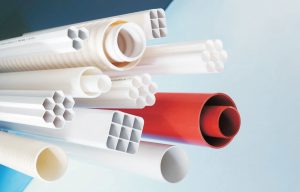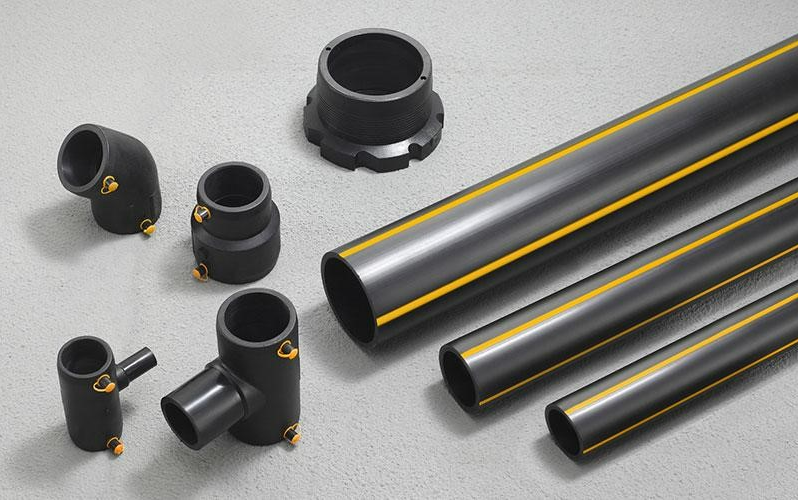Polyethylene (PE) is the simplest polymer organic compound, and the most widely used and recognized thermoplastic material in the world today. If you don’t know much about chemistry, it doesn’t matter, because your daily life may be closely related to PE pipes.
As a piping material, PE pipe offers distinct advantages like light weight, good flexibility, chemical resistance, high durability and long service life, which making it a proper piping material for a wide variety of applications such as distribution lines, drinking water systems, natural gas distribution, and drainage lines. Here are some facts about PE water supply pipes that you may be interested in.
What is PE Water Supply Pipe?
Using polyethylene as a raw material, PE water supply pipes are formed through a process known as extrusion, which can easily regulate the size of pipes during production. There are the following three characteristics of PE water supply pipes:
1. Corrosion resistance
PE water pipes can withstand various chemicals so they have high durability and a long life span. Besides the common advantages of plastic pipes like lightweight, lower water consumption and low cost, this feature is the main reason why the cast iron pipes and steel pipes are replaced by PE water supply pipes.
2. Flexibility and good weldability
To supply water to whole urban and rural areas, water supply pipes must have good flexibility and be easy to weld during connection, which highlights the great value of PE water pipe.
3. Long temperature resistance
PE water supply pipe can withstand the low temperature of -70℃, which is superior to other types of pipes and more suitable for areas with cold winter that are below zero. Following, we will introduce the PE water supply pipe construction process in detail.
PE Water Supply Pipe Construction Process
In order to guarantee the quality of the pipeline construction project, the construction contractor should know well about the characteristics of PE pipe and construct in accordance with the standard requirements of relevant technical specifications or technical manuals.
1. Engineering Measurement
Before excavating the pipe trench, measure the coordinate points and elevation points of the site terrain and design the construction sketch according to the measurement results. Accurate engineering measurement is the preparation for smoothly building a water pipeline.
2. Excavation of Pipe Trench
Excavate the pipe trench with small machinery and manually excavate the pipe groove. When grooving, you must carefully pay attention to the current pipelines and other obstacles at the intersection. The excavation width of the trench bottom is DN+0.30m to avoid disturbing the bottom of the soil layer, and the width of the groove bottom of the pipeline should not be less than DN+0.50m to facilitate installation and connection.
3. Install PE pipeline
The construction of the pipeline foundation can only be carried out after the trench excavation is completed. The soil layer of the excavation trench should be solid to ensure that the pipe can be smoothly supported, and the loose soil should be dug out and backfilled again.
4. Steps to Connect PE Pipe
There are mainly two methods for PE pipe connection: hot melt connection and electrofusion connection. Here are the steps taken in the hot-melt connection.
- First, the connection interface of the hot melt joint should be flat. Place the pipes on the butt joint machine and cut to ensure that the end faces of the two welded pipe sections are completely aligned.
- Second, heat the two identical connection interfaces with a hot plate to a viscous flow state. The temperature of the butt joint is generally between 210-230℃ and the heating time is different according to the seasons.
- Third, remove the hot plate and then adhere two end faces under melting pressure, which is the key to welding.
- Finally, let the interface cool slowly and solidify the docking under pressure. After cooling, you can remove the docking machine.
5. Valve installation
Before installing the exhaust valve, ensure that there is sufficient adjustment space for the valves and bolts, and the operating machinery and rotating devices should be adjusted before use. The installation height is generally 1 to 1.2 meters from the ground with the hand wheel.
6. Pipeline Hydrostatic Test
After the pipeline is installed and laid, it is necessary to conduct a hydrostatic test of the pipeline to ensure its strength and tightness.
7. Backfill and Compact
Backfill it from both sides of the pipe at the same time, and the backfill layer should be compacted as required to prevent displacement. After the pipeline hydrostatic test, a large area should be backfilled when the pipeline is full of water. It is not advisable to stay in the empty pipe for an extended period of time after it has been laid.
Tips: Plastic pipes are less rigid and resistant to impact than metal pipes. In the entire process of PE pipeline construction, attention should be paid to preventing the PE pipe fittings from being damaged by mechanical equipment at a certain ultra-low temperature.


Summary
The above is the PE water supply pipe construction process and plan. We hope it will be helpful to you. If you plan to buy high-quality PE water supply pipes or other plastic pipes, you can contact us at any time. LESSO, the PE water supply pipe provider, has a professional service team and will provide you with reliable support for various pipe materials and help you buy high-quality and low-cost PE pipes. If you want to know about other types of pipes, don’t forget to subscribe to us!


What’s the Difference Between PVC Pipe and PVC Conduit
Table of Contents PVC or Polyvinyl Chloride pipes use vinyl and plastic materials. We use these pipes in plumbing systems. If you do not want


How Temperature Affects PVC Pipe
Table of Contents PVC pipes are most commonly utilized in manufacturing water mains, sewage pipes, as well as irrigation. These pipes not only have long-lasting








